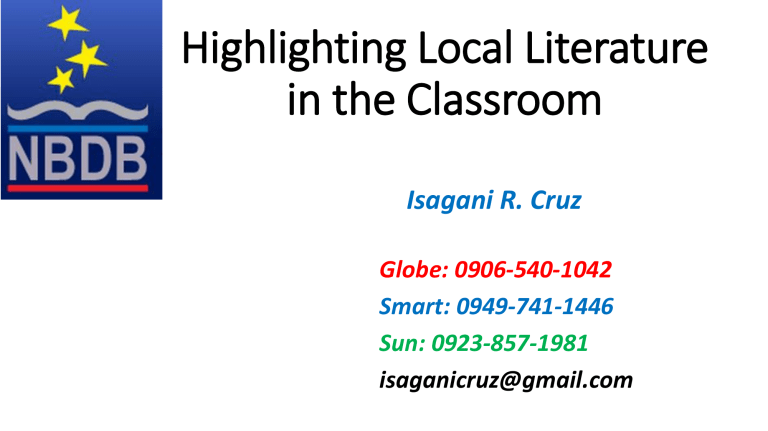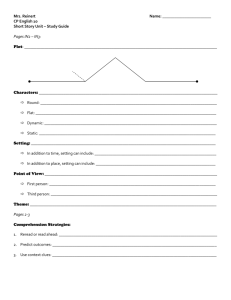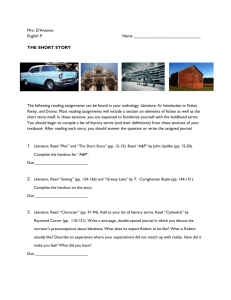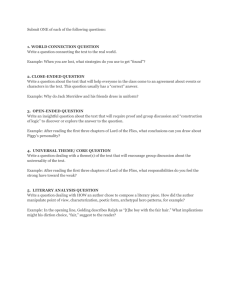problem & solution

Highlighting Local Literature in the Classroom
Isagani R. Cruz
Globe: 0906-540-1042
Smart: 0949-741-1446
Sun: 0923-857-1981 isaganicruz@gmail.com
K to 12
College
Readiness
Standards
New General
Education
Curriculum
Pag-unawa sa Sarili Etika Pagpapahalaga sa Sining
Mga Babasahin hinggil sa Kasaysayan ng Filipinas
Ang Kasalukuyang Daigdig Malayuning Komunikasyon
Matematika sa Makabagong Daigdig Agham, Teknolohiya, at
Core
Lipunan
(24 u.)
Mandated
Elective
(9 u.)
GE
Rizal, PE, NSTP, Taxation,
Agrarian Reform, Philippine
Constitution, Family Planning,
Population Education
•
Understanding the Self Readings in Phil History
The Contemporary World
Mathematics in the Modern World
Purposive Communication
Ethics
Art Appreciation Core ST & Society
(24 u.)
Mandated
Elective
(9 u.)
GE
Rizal, PE, NSTP, Taxation,
Agrarian Reform, Philippine
Constitution, Family Planning,
Population Education
Produce all forms of texts (e.g., written, oral, visual, digital) based on: a solid grounding on Philippine experience and culture; an understanding of the self, community, and nation; the application of critical and creative thinking and doing processes; competency in formulating ideas/arguments logically, scientifically, and creatively; and a clear appreciation of one’s responsibility as a citizen of a multicultural Philippines and a diverse world.
The geographic, linguistic, and ethnic dimensions of Philippine literary history from pre-colonial to the contemporary.
Enumerate the themes, structures, and elements of myths, traditional narratives, and classical and contemporary literature.
The names and works of all the Philippine National Artists in literature.
Identify the contributions of the canonical Filipino writers to the development of national literature.
The names and works of at least ten writers from the region where the high school is located.
Identify the contributions of local writers to the development of regional literary traditions.
The names and works from different national literatures and cultures, namely, Asia, Anglo-American, European, Latin America,
North Africa.
Compare and contrast cultural and literary traditions across the globe.
Literary and non-literary uses of language.
Distinguish the literary uses of language from the non-literary.
Formal features and conventions of literature.
Recite poems and perform plays.
Formal features and conventions of literature.
Identify the characters, setting, theme, conflict, and type of a work of fiction.
Formal features and conventions of literature.
Distinguish chronology from plot.
Literary meanings in contexts.
Write a critical paper that analyses literary texts in relation to the context of the reader and the writer.
Critical strategies.
Write a critical paper that interprets literary texts using any of the critical approaches.
First, to effect a smooth transition from basic education to tertiary
English
prepared the College Readiness Standards
Filipino
subjects:
Literature
Social Studies , and Science
Humanities
Science
October
28, 2011 , the College Readiness Standards were approved by the commission en banc.
Language and Literacy
Creative Writing
Creative Writing
Competence
An effective language arts and multiliteracies curriculum draws on literature in order to develop students’ understanding of their literary heritage.
Naipapamalas ng mag-aaral ang pag-unawa at pagpapahalagang pampanitikan gamit ang teknolohiya at iba’t ibang uri ng teksto at mga akdang pampanitikang rehiyunal, pambansa, saling-akdang Asyano at pandaigdig tungo sa pagtatamo ng kultural na literasi.
LEVEL CONTENT
Rhyme
K
Character,
Setting, Plot
Closure
COMPETENCY
Recite rhymes, poems, and sing simple jingles/songs in the mother tongue, Filipino and/or English
Identify whether a pair or set of words rhyme
Recall details of the story told by the teacher: the characters, when and where the story happens, the events in the story
Predict what might happen next in the story heard
LEVEL
1
CONTENT
Rhyme
Interpretation
Character
Persona
Closure
Criticism
COMPETENCY
Identify rhyming words in nursery rhymes, songs, jingles, poems, and chants
Recite and sing individually, with ease and confidence, songs, poems, chants, and riddles
Infer the character feelings and traits in a story listened to
Identify the speaker in the story or poem listened to
Predict possible ending of a story listened to
Participate actively during story reading by making comments and asking questions
LEVEL CONTENT
Character,
Setting, Plot
1
Plot
Creative
Writing
Plausibility
Structure
Criticism
Adaptation
COMPETENCY
Note important details in grade level narrative texts listened to: (a) character, (b) setting, (c) events
Give the correct sequence of three events in a story listened to
Supply rhyming words to complete a rhyme, poem, and song
Identify cause and/or effect of events in a story listened to
Identify the problem and solution in the story read
Discuss, illustrate, dramatize specific events in a story read
LEVEL CONTENT
Paraphrase 1
Close Reading
Interpretative
Reading
Author
COMPETENCY
Retell a story read
Tell/retell legends, fables, and jokes
Note important details in grade level literary texts listened to
Nababasa ang usapan, tula, talata, kuwento nang may tamang bilis, diin, tono, antala, at ekspresyon
Naipamamalas ang paggalang sa ideya, damdamin, at Kultura ng may akda ng tekstong napakinggan o nabasa
LEVEL CONTENT
Value 1
Creative
Writing
COMPETENCY
Napahahalagahan ang mga tekstong pampanitikan sa pamamagitan ng aktibong pakikilahok sa usapan at gawaing pampanitikan
Pagsulat ng tula at kuwento
LEVEL CONTENT
2
Character,
Setting, Plot
Appreciation
Background
Structure
Character
Genre
Theme
Synopsis
Metaphor
COMPETENCY
Note important details in grade level narrative texts: (a) character, (b) setting, (c) plot
Express individual choices and taste for texts
Browse/read books for various purposes such as for learning or for pleasure
Identify the important story elements
Infer character feelings and traits in a story
Identify the difference between a story and a poem
Give the main idea of a story/poem
Give the summary of a story
Identify and use simile and metaphor in sentences
LEVEL CONTENT
Titles
Intention
2
Appreciation
COMPETENCY
Give another title for literary text
Identify the author’s purpose for writing a selection
Show love for reading by listening attentively during story reading and by making comments/reactions
Naipamamalas ang pagpapahalaga at kasanayan sa pagbasa ng iba’t ibang uri ng
Panitikan
Napapahalagahan ang mga tekstong pampanitikan
LEVEL CONTENT
Affect
2
Criticism
COMPETENCY
Nakadarama ng pagbabago sa sariling damdamin at pananaw batay sa binasang teksto
Naipakikita ang aktibong pakikilahok sa usapan at gawaing pampanitikan
Nauunawaan ang kahalagahan ng mga nilalaman ng panitikan
LEVEL CONTENT
Character,
Setting, Plot
3
Appreciation
Genre
Paraphrase
Figures of speech
Theme
COMPETENCY
Note important details in grade level narrative texts: (a) character, (b) setting, (c) plot
(problem & solution)
Expresses love for stories and other texts by browsing the books read to them and asking to be read more stories and texts
Identify the difference between a story and a poem
Give the meaning of a poem
Identifies and uses personification, hyperbole
Gives the main idea of a story/poem
LEVEL CONTENT
3
Character
Structure
Closure
Adaptation
Appreciation
Title
Stylistics
Appreciation
COMPETENCY
Infers character feelings and traits in a story
Identifies the important story elements
Predicts possible ending of a story
Responds to a story through dramatization, songs, or art activities
Shows love for reading by listening attentively during story reading and making comments or reactions
Give another title for literary text
Describes and reacts to the author’s writing style
Napapahalagahan ang mga tekstong pampanitikan
LEVEL CONTENT
7
COMPETENCY
As language
Pre-colonial literature
Proverbs,
Myths, Legends
Demonstrates communicative competence through his/her understanding of Philippine
Literature
Demonstrates understanding of pre-colonial
Philippine literature as a means of connecting to the past
Transfers learning by showing appreciation for the literature of the past
Describes the different literary genres during the pre-colonial period
Identify the distinguishing features of proverbs, myths, and legends
LEVEL CONTENT
7
COMPETENCY
Genre
Imagery
Devices
Tone, Intention
Theme
Context
Explain how the elements specific to a genre contribute to the theme of a particular literary selection
Express appreciation for sensory images used
Explain the literary devices used
Determine the tone, mood, technique, and purpose of the author
Draw similarities and differences of the featured selections in relation to the theme
Explain how a selection may be influenced by culture, history, environment, or other factors
LEVEL CONTENT
7
COMPETENCY
Conflict, Theme
Period
Genre
Psychology
Period
Discover the conflicts presented in literary selections and the need to resolve those conflicts in non-violent ways
Identify the distinguishing features of literature during the Period of Apprenticeship
Identify the distinguishing features of poems and short stories
Discover literature as a tool to assert one’s unique identity and to better understand other people
Identify the distinguishing features of literature during the Period of Emergence
LEVEL CONTENT
Genre
7
Theme
Period
Author
COMPETENCY
Identify the distinguishing features of revolutionary songs, poems, short stories, drama, and novels
Discover through Philippine literature the need to work cooperatively and responsibly in today’s global village
Identify the distinguishing features of selected literary genres during the Contemporary
Period
Explain the contributions of national artists for literature in elevating Philippine Literature in English in the global village
LEVEL CONTENT
Kuwentong
Bayan
7
Pabula
Synopsis
Street Drama
Folksong
COMPETENCY
Naisusulat ang mga patunay na ang kuwentong-bayan ay salamin ng tradisyon o kaugalian ng lugar na pinagmulan nito
Naibabahagi ang sariling pananaw at saloobin sa pagiging karapatdapat / di karapatdapat ng paggamit ng mga hayop bilang mga tauhan sa pabula
Naisusulat ang buod ng binasang kuwento nang maayos
Nabubuo ang patalastas tungkol sa napanood na dulang panlansangan
Naisasagawa ang dugtungang pagbuo ng bulong at/o awiting-bayan
LEVEL CONTENT
Alamat
Epiko
7
Ibong Adarna
Korido
COMPETENCY
Naisusulat ang isang alamat sa anyong komiks
Naisasagawa ang isahan / pangkatang pagsasalaysay ng isang pangyayari sa kasalukuyang na may pagkakatulad sa mga pangyayari sa epiko
Naibabahagi ang sariling ideya tungkol sa kahalagahan ng pag-aaral ng Ibong Adarna
Nakikilahok sa malikhaing pagtatanghal ng ilang saknong ng korido na naglalarawan ng pagpapahalagang Pilipino
LEVEL CONTENT
Afro-Asian Lit
8
African Lit
Figures of speech
COMPETENCY
Demonstrates communicative competence through his/her understanding of Afro-Asian
Literature
Demonstrates understanding of African literature as a means of exploring forces that human beings contend with
Describe the notable literary genres contributed by African writers
Identify the distinguishing features of notable
African chants, poems, folktales, and short stories
Explain figurative language used
LEVEL CONTENT
8
COMPETENCY
Genre
Imagery
Tone, Intention
Theme
Criticism
Devices
Explain how the elements specific to a genre contribute to the theme of a particular literary selection
Express appreciation for sensory images used
Determine the tone, mood, technique, and purpose of the author
Describe similarities and differences of the featured selections in relation to the theme
Explain how a selection may be influenced by culture, history, environment, or other factors
Explain the literary devices used
LEVEL CONTENT
8
COMPETENCY
East Asian Lit
Nature
Southeast Asian
Lit
Tone, Theme,
Intention
Describe the notable literary genres contributed by East Asian writers
Identify the distinguishing features of notable
East Asian poems, folktales, and short stories
Appreciate literature as an art form inspired and influenced by nature
Describe the notable literary genres contributed by Southeast Asian writers
Identify the distinguishing features of notable poems, short stories, dramas, and novels contributed by Southeast Asian writers
Determine key ideas, tone, and purposes of the author
LEVEL CONTENT
8
COMPETENCY
South and West
Asian Lit
Philosophy,
Religion
Riddles,
Proverbs
Interpretative
Reading
Describe the notable literary genres contributed by South and West Asian writers
Identify the distinguishing features of religious texts, epics, myths, drama, and short stories contributed by South and West Asian writers
Appreciate literature as an expression of philosophical and religious ideals
Naisusulat ang sariling bugtong, salawikain, sawikain, o kasabihan na angkop sa kasalukuyang kalagayan
Nabibigkas nang wasto at may damdamin ang tula
LEVEL CONTENT
Sarsuwela
8
Creative
Writing
Florante at
Laura
COMPETENCY
Nasusuri nang pasulat ang papel na ginagampanan ng sarsuwela sa pagpapataas ng kamalayan ng mga Pilipino sa Kultura ng iba’t ibang rehiyon sa bansa
Naisusulat ang isang orihinal na tulang may apat o higit pang saknong sa alinmang anyong tinalakay, gamit ang paksang pag-ibig sa kapwa, bayan, o kalikasan
Nabibigkas nang madamdamin ang mga sauladong berso ng Florante at Laura
LEVEL CONTENT
British and
American Lit
9
Theme
Mood
COMPETENCY
Demonstrates communicative competence through his/her understanding of British-
American Literature
Demonstrates understanding of how Anglo-
American literature serves as a means of discovering and enhancing the self
Identify the distinguishing features of notable
Anglo-American lyric poetry, sonnets, dramatic poetry, vignettes, songs, poems, sermons, allegories, short stories, and one-act plays
Explain how the elements specific to a selection build its theme
LEVEL CONTENT
9
COMPETENCY
Tone, Intention
Theme
Context
Determine the tone, mood, technique, and purpose of the author
Draw similarities and differences of the featured selections in relation to the theme
Explain how a selection may be influenced by culture, history, environment, or other factors
Analyze literature as a means of valuing other people and their circumstances in life
Explain how the elements specific to a genre contribute to the theme of a particular literary selection
LEVEL CONTENT
Genre
9
Dialogue
Reviewing
Theme
Short Story
COMPETENCY
Analyze a radio play as a means of connecting to the world
Analyze dialogue as one of the elements in building the theme of a play
Compose a play review
Explain how the elements specific to fulllength plays build its theme as a means of understanding unchanging values in a changing world
Nasusuri ang maikling kuwento batay sa paksa, mga tauhan, pagkakasunod-sunod ng mga pangyayari, estilo sa pagsulat ng awtor
LEVEL CONTENT
9
COMPETENCY
Verisimilitude
Tanka & Haiku
Creative
Writing
Criticism
Parable
Elegy
Noli me tangere
Nasusuri ang pagiging makatotohanan ng ilang pangyayari sa isang dula
Naisusulat ang payak na tanka at haiku sa tamang anyo at sukat
Naisusulat ang isang maikling dula tungkol sa karaniwang buhay ng isang grupo ng Asyano
Nasasaliksik ang kulturang nakapaloob sa alinmang dula sa Silangang Asya
Naisasadula ang nabuong orihinal na parabola
Nakasusulat ng sariling elehiya para sa isang mahal sa buhay
Naitatanghal ang scenario building tungkol kay Sisa sa makabagong panahon
LEVEL CONTENT
10
COMPETENCY
British and
American Lit
Theme
Imagery
Tone, Intention
Demonstrates communicative competence through his/her understanding of literature for a deeper appreciation of World Literature, including Philippine Literature
Demonstrates understanding of how world literature serves as a way of expressing and resolving one’s personal conflicts
Explain how the elements specific to a selection build the theme of a particular literary selection
Express appreciation for sensory images used
Determine tone, mood, technique, and purpose of the author
LEVEL CONTENT
Context
10
Theme
Devices
Theme
COMPETENCY
Explain how a selection may be influenced by culture, history, environment, or other factors
Draw similarities and differences of the featured selections in relation to the theme
Explain the literary devices used
Evaluate literature as a vehicle of expressing and resolving conflicts between and among individuals or groups
Evaluate literature as a source of wisdom in expressing and resolving conflicts between individuals or groups, societies, and nature
LEVEL CONTENT
10
COMPETENCY
Myth
Epic
Novel
Mediterranean
Lit
Creative
Writing
Naisusulat ang sariling mitolohiya batay sa paksa ng akdang binasa
Naisusulat ang paglalahad ng pananaw tungkol sa pagkakaiba-iba, pagkakatulad ng mga epikong pandaigdig
Naisasadula ang isang pangyayari sa tunay na buhay na may pagkakatulad sa mga piling pangyayari sa kabanata ng nobela
Nailalahad nang malinaw sa isang simposyum ang nabuong critique ng alinmang akdang pampanitikang Mediterranean
Naisasalaysay ang nabuong anekdota sa isang diyalogo aside, soliloquy, o monolog
LEVEL CONTENT
African Lit
Persian Lit
10
El
Filibusterismo
Character
COMPETENCY
Naisusulat ang iskrip ng isang puppet show na naglalarawan sa tradisyong kinamulatan sa
Africa at/o Persia
Naisasalaysay ang magkakaugnay na mga pangyayari sa pagkakasulat ng El
Filibusterismo
Naisasagawa ang angkop na pagsasatao ng mga tauhan ng nobela
Senior High School
CORE CURRICULUM SUBJECTS
1. Oral Communication
2. Reading and Writing
3. Komunikasyon at Pananaliksik sa Wika at Kulturang
Pilipino
4. Pagbasa at Pagsuri ng Iba’t Ibang Teksto Tungo sa
Pananaliksik
5. 21st Century Literature from the Philippines / 21st Century
Literature from the World
Senior High School
CORE CURRICULUM SUBJECTS
6. Contemporary Arts from the Regions
7. Media and Information Literacy
8. General Mathematics
9. Statistics and Probability
10. Earth and Life Science (STEM: Earth)
11. Physical Science (STEM: Disaster Readiness and Risk
Reduction)
12. Introduction to Philosophy of the Human Person
Senior High School
CORE CURRICULUM SUBJECTS
12. Introduction to Philosophy of the Human Person
13. Physical Education and Health
14. Personal Development
15. Understanding Culture, Politics, and Society
Senior High School
CONTEXTUALIZED TRACK SUBJECTS
1. English for Academic and Professional Purposes
2. Research in Daily Life 1: Qualitative Research in Daily Life
3. Research in Daily Life 2: Quantitative Research in Daily Life
4. Pagsulat sa Filipino sa Piling Larangan (Akademik, Isports,
Sining, at Tech-Voc)
5. Empowerment Technologies (E-Tech): ICT for Professional
Tracks
6. Entrepreneurship
7. Research Project / Culminating Activity
LEVEL CONTENT
11
COMPETENCY
21 st century literature from the region where the school is based in relation to the literature of other regions
Identify the geographic, linguistic, and ethnic dimensions of Philippine literary history from pre-colonial to the contemporary
Identify representative texts and authors from each region
Value the contributions of local writers to the development of regional literary traditions
Appreciate the contributions of the canonical
Filipino writers to the development of national literature
LEVEL CONTENT
11
COMPETENCY
21 st century literature from the region where the school is based in relation to the literature of other regions
Differentiate / Compare and contrast the various 21 st century literary genres and the ones from the earlier genres / periods, citing their elements, structures, and traditions
Infer literary meaning from literal language based on usage
Analyze the figures of speech and other literary techniques and devices in the text
Explain the literary, biographical, linguistic, and sociocultural contexts and discuss how they enhance the text’s meaning and enrich the reader’s understanding
LEVEL CONTENT
11
COMPETENCY
21 st century literature from the region where the school is based in relation to the literature of other regions
Situate the text in the context of the region and the nation
Explain the relationship of context with the text’s meaning
Produce a creative representation of a literary text by applying multimedia skills
Choose an appropriate multimedia format in interpreting a literary text
Apply ICT skills in crafting an adaptation of a literary text
Do self- and/or peer-assessment of the creative adaptation of a literary text, based on rationalized criteria, prior to presentation
LEVEL CONTENT
11
COMPETENCY
21 st century literature of the world
Identify representative texts (originally written in the 21 st century) and authors from
Asia, North America, Europe, Latin America, and Africa
Explain the texts in terms of literary elements, genres, and traditions
Situate the texts in the context of the region, nation, and the world
Appreciate the cultural and aesthetic diversity of literature of the world
Compare and contrast the various 21 st century literary genres and their elements, structures, and traditions from across the globe
LEVEL CONTENT
11
COMPETENCY
21 st century literature of the world
Distinguish the literary uses of language from the non-literary and understand their use as well as the formal features and conventons of literature
Identify the figures of speech and other literary techniques and devices in the text
Explain the biographical, linguistic, and sociocultural contexts and discuss how they enhance the text’s meaning and enrich the reader’s understanding
Examine the relationship between text and context
LEVEL CONTENT
11
COMPETENCY
21 st century literature of the world
Understand literary meanings in context and the use of critical reading strategies
Produce a creative representation of a literary text by applying multimedia skills
Choose an appropriate multimedia format in interpreting a literary text
Apply ICT skills in crafting an adaptation of a literary text
Do self- and/or peer-assessment of the creative adaptation of a literary text, based on rationalized criteria, prior to presentation
Filipinos y filipinistas (1909)
Algo de Prosa (1909)
Literatura Tagala (1911)
El Teatro Tagala (1911)
Nuestra Literatura (1913)
El Proceso del Dr. José Rizal (1914)
Folklore Musical de Filipinas (1920)
Filipinas para los Filipinos
Cuentos y paisajes Filipinos
Criminality in the Philippines http://en.wikipedia.org/wiki/Epifanio_de_los_Santos
http://en.wikipedia.org/wiki/Linda_Ty_Casper
The Peninsulares (1964)
The Three-Cornered Sun (1974)
Dread Empire (1980)
Hazards of Distance (1981)
Fortress in the Plaza (1985)
Awaiting Trespass (1985)
Wings of Stone (1986)
A Small Party in a Garden (1988)
Dream Eden (1996)
Sa Balantok ng Bahaghari at Iba pang Tula (1975)
Handog ng Kalayaan (1979)
Munting Patak-ulan (2009) http://rizal.lib.admu.edu.ph/aliww/filipino_gvguzman.htm
Og Uhog
Filemon Mamon
Batang Rizal
Mga Kwento ni Lola Basyang http://rizal.lib.admu.edu.ph/aliww/filipino_gvguzman.htm
Philippines, My Gift from God (Grades 3 & 4)
Pilipinas, Kaloob ng Diyos (Grades 3 & 4)
English, My Gift from God (Grade 2)
Reading, My Gift from God (Grades 2 & 3)
Mga Bugtong at Salawikain Para sa Bagong Henerasyon https://www.facebook.com/vivian.tica
Nobelang Tagalog, 1905-1975: Tradisyon at
Modernismo (1982)
The Romance Mode in Philippine Popular Literature and
Other Essays (1991)
Pagbasa ng Panitikan at Kulturang Popular: Piling
Sanaysay, 1976-1999 (1999)
From Darna to Zsazsa Zaturnnah: Desire and Fantasy:
Essays on Literature and Popular Culture (2009)
A Dark Tinge to the World: Selected Essays (1987-2005)
(2005)
This presentation can be downloaded from: http://kto12plusphilippines.com/
Globe:
0906-540-1042
Smart:
0949-741-1446
Sun:
0923-857-1981 isaganicruz@ gmail.com








